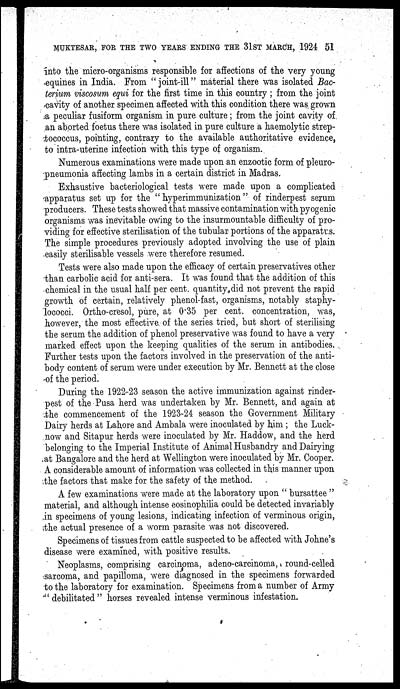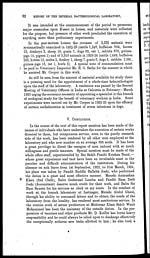Medicine - Veterinary > Veterinary colleges and laboratories > Annual report of the Imperial Bacteriological Laboratory, Muktesar > 1923-1924 - Annual report of the Imperial Bacteriological Laboratory, Muktesar for the two years ending the 31st March, 1924
(355) Page 51
Download files
Individual page:
Thumbnail gallery: Grid view | List view

MUKTESAR, FOR THE TWO YEARS ENDING THE 31ST MARCH, 1924 51
into the micro-organisms responsible for affections of the very young
equines in India. From "joint-ill" material there was isolated Bac-
terium viscosum equi for the first time in this country ; from the joint
cavity of another specimen affected with this condition there was grown
a peculiar fusiform organism in pure culture ; from the joint cavity of
an aborted foetus there was isolated in pure culture a haemolytic strep-
tococcus, pointing, contrary to the available authoritative evidence,
to intra-uterine infection with this type of organism.
Numerous examinations were made upon an enzootic form of pleuro-
pneumonia affecting lambs in a certain district in Madras.
Exhaustive bacteriological tests were made upon a complicated
apparatus set up for the " hyperimmunization " of rinderpest serum
producers. These tests showed that massive contamination with pyogenic
organisms was inevitable owing to the insurmountable difficulty of pro-
viding for effective sterilisation of the tubular portions of the apparatus.
The simple procedures previously adopted involving the use of plain
easily sterilisable vessels were therefore resumed.
Tests were also made upon the efficacy of certain preservatives other
than carbolic acid for anti-sera. It was found that the addition of this
chemical in the usual half per cent. quantity did not prevent the rapid
growth of certain, relatively phenol-fast, organisms, notably staphy-
lococci. Ortho-cresol, pure, at 0.35 per cent. concentration, was,
however, the most effective of the series tried, but short of sterilising
the serum the addition of phenol preservative was found to have a very
marked effect upon the keeping qualities of the serum in antibodies.
Further tests upon the factors involved in the preservation of the anti-
body content of serum were under execution by Mr. Bennett at the close
of the period.
During the 1922-23 season the active immunization against rinder-
pest of the Pusa herd was undertaken by Mr. Bennett, and again at
the commencement of the 1923-24 season the Government Military
Dairy herds at Lahore and Ambala were inoculated by him ; the Luck-
now and Sitapur herds were inoculated by Mr. Haddow, and the herd
belonging to the Imperial Institute of Animal Husbandry and Dairying
at Bangalore and the herd at Wellington were inoculated by Mr. Cooper.
A considerable amount of information was collected in this manner upon
the factors that make for the safety of the method.
A few examinations were made at the laboratory upon " bursattee "
material, and although intense eosinophilia could be detected invariably
in specimens of young lesions, indicating infection of verminous origin,
the actual presence of a worm parasite was not discovered.
Specimens of tissues from cattle suspected to be affected with Johne's
disease were examined, with positive results.
Neoplasms, comprising carcinoma, adeno-carcinoma, round-celled
sarcoma, and papilloma, were diagnosed in the specimens forwarded
to the laboratory for examination. Specimens from a number of Army
" debilitated " horses revealed intense verminous infestation.
Set display mode to: Large image | Zoom image | Transcription
Images and transcriptions on this page, including medium image downloads, may be used under the Creative Commons Attribution 4.0 International Licence unless otherwise stated. ![]()
| Permanent URL | https://digital.nls.uk/75223147 |
|---|
| Additional NLS resources: | |
|---|---|




